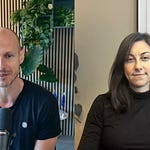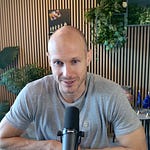Welcome back to another episode of the EUVC Podcast, where we gather Europe’s venture family to share the stories, insights, and lessons that drive our ecosystem forward. Today’s conversation takes us on a global journey from Croatia to San Francisco to uncover how one founder caught lightning in a bottle and is now racing to harness it.
Our guest: Ivan Burazin, founder of Daytona. With a career spanning Toronto, Croatia, Infobip, Shift Conference, and now Daytona, Ivan brings a rare, global perspective on how Europe can lead in DevTools and AI infrastructure. Alongside him, our dear friend Enis Hulli from E2VC joins to spotlight Daytona’s story, the lessons from its dramatic pivot, and what it means for founders and investors navigating this new AI wave.
🎧 Listen on Apple or Spotify — or queue it for later with chapters ready to go.
The Setup: From Dev Communities to Global Scale
Ivan has spent two decades at the intersection of infrastructure and developer communities. From racking servers in the early 2000s to launching one of the first browser-based IDEs in 2009 to scaling the Shift Conference to thousands of attendees, his career has consistently circled around enabling developers.
Daytona’s first act was a cloud IDE provider for enterprises — “one-click setup for secure developer environments.” With Fortune 500 customers onboard, revenue flowing, and a healthy pipeline, Daytona 1.0 showed promise. But something was missing.
The Pivot: From Humans to Agents
Six months ago, Ivan and his team made a bold decision to pivot. Daytona 2.0 is no longer about provisioning dev environments for humans — it’s about powering AI agents with the computers they need.
“Agents are not computers themselves. They need access to computers to run browsers, clone repos, analyze data. Daytona gives them that — an isolated sandbox with machine-native interfaces built for agents.” – Ivan
The differences between human and agent runtimes turned out to be massive:
Humans tolerate 30 seconds of spin-up; agents need milliseconds.
Humans solve problems sequentially; agents branch into parallel “multiverse” solutions.
Humans parse terminal output; agents require clean APIs.
By recognizing this, Daytona carved out a new category: the computer for agents.
Why San Francisco?
The pivot coincided with a deliberate move to San Francisco. Ivan recalls how Figma embedded with designers at Airbnb, or how Twilio found adoption among early Valley startups. To own mindshare in a new category, location mattered.
“From San Francisco outwards, adoption flows naturally. From Europe inwards, it’s like pushing uphill.” – Ivan
So Daytona went all-in: presence at AI meetups, team members flying in and out, and early product evangelism on the ground.
Catching Lightning: The Pull of AI Agents
HAfter the pivot, Daytona saw extraordinary pull from the market:
Customer conversations ended with “send me the API key”.
Infrastructure demand showed power-law dynamics: just a handful of fast-growing customers could drive scale.
Instead of polished decks, Ivan shared raw revenue dashboards with authenticity.
The momentum was immediate and tangible.
🤝 The VC Angle: Pivoting with Support
Ivan admits he hadn’t explicitly asked permission to pivot. He hinted at it in updates, tested the idea with a hackathon, and only later informed his cap table. The response? Overwhelmingly positive.
Enis highlights this as a key distinction: experienced angels with broad portfolios encourage bold swings, while less diversified angels may fear the risk.
Scaling the Genie
Catching lightning is one thing. Harnessing it is another. Ivan’s current focus:
Hiring deliberately: keeping the team small and ownership-driven.
White-glove onboarding: every serious customer gets a Slack channel with the whole team.
Balancing speed and reliability: ship daily, but solve today’s scale problems without over-engineering.
Seed-Strapping, Governance, and What’s Next
Enis introduces a new term: seed-strapping — raising a seed, skipping A and B, and scaling straight to unicorn status.
Ivan is cautious. Infra is capital-intensive, and while Daytona could raise a Series A today, he’s committed to doing it on his terms:
“If I can raise from angels and the community, then the fund needs to offer more than guardrails. Otherwise, why take the dilution?” – Ivan
🌍 Takeaways for Founders & VCs
Pivoting takes conviction — and earns respect when done boldly.
Product-market fit feels like chaos. If customers chase you for API keys and Slack is on fire, you’re onto something.
Location matters: SF remains the gravitational center for AI.
Scaling requires discipline: careful hiring, white-glove support, and balanced execution.
Capital strategy is leverage: revenue gives founders the power to demand more from investors.









